Welcome to FISH FOOD TIMES


Apr. 2015 issue No.136


Fillets with bone,with head of Ruby snapper
Ruby snapper that formal Japanese name hamadai, which is also referred to as a "Akamachi" in Okinawa, become a named very similar to go to the Amami region "Akamatsu", Long-tailed in the Kanto, further in some other areas and referred by the name of "heiji" seems to be.
It's a fish under the right image that is very similar to ruby snapper. Although clearly the difference when arranging the images as shown below are known, it is entirely enough to get lost was either a moment determined whether Looking at each elsewhere.
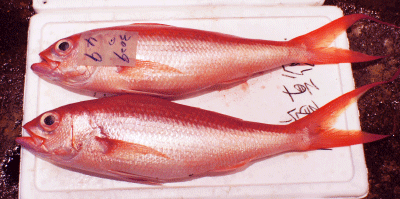 �@
�@
Fish of the upper-left image is referred to as the "Akamachi" in Okinawa, is a Ruby snapper are treated as luxury fish of white, and the right of very similar fish that will not be treated only by market basis that less than half of the price is a fish that Rover, local name is called Chouchinuo in Okinawa, and further in the Amami Islands is called Akabo.
Ruby snapper is a Suzuki system Perciformes Percoidei Snapper Etelis genus, but one fish had been given a high selling price of 2,200 yen as the image below in the fish department of a store, this price is only this day instead of that special high, is a fish that this much of the selling price is valid in common.
The Snapper that Ruby snappe belongs, Lutjanus, Pristipomoides, divided into such Paracaesio, you are there is a lot of relatives and brothers of about 30 kinds.

On the other hand Rovers belonging to Suzuki system Perciformes Percoidei Emmelichthyidae, this such as brothers relatives in other to its belonging Emmelichthyidae there is a difference that there are few.
Fish Snapper is's a white meat as a base, but, Rovers color of the meat is red as blue fish, and but have a reddish body as if bonito and tuna, as shown in the following image, oddly enough this fish is classified as white meat categories.
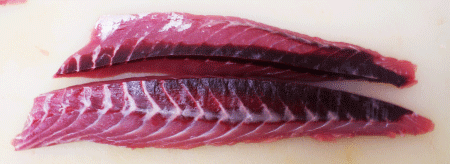
This is is as follows as to hiratsukuri sashimi, but not also be the color of the body does not look like a raw bonito, Rovers is neither bonito, and please do not mistake because it does not even ruby snapper.
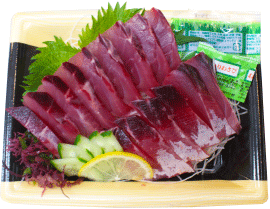
And the image below is a ruby snapper, you think clear distinction in comparison with the image of the top of the meat color differences.
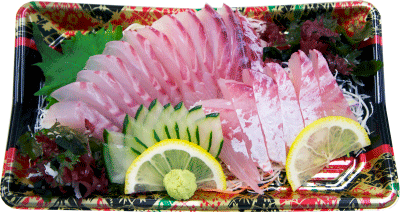 �@�@
�@�@
April-May is the time it is while stored fat before ruby snapper greet the spawning of summer. Originally ruby snapper of subcutaneous fat is not the one with a lot lightly taste, as if it were farmed sea bream comes to this season, are in accumulated visceral fat enough to not think natural fish. And the taste is not unlike those greasy as aquaculture sea bream, can feel the fat ride seems natural fish.
Even by simply confirming the fact of the thus inflated visceral fat, the season can be seen that ruby snapper is the most delicious time a year. And ruby snapper to eat delicious, not only orthodox How to eat sashimi without skin as above image, utilizing the "yakijimo technique" that eat the bright red color of the skin together as below image sashimi is also recommended.
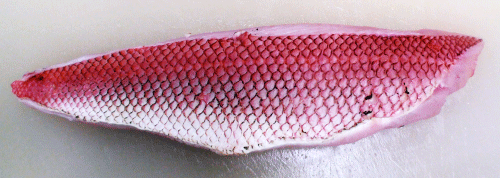
When the yakijimo is, taste it is aroma that was roasted firmly enough get a little sear.
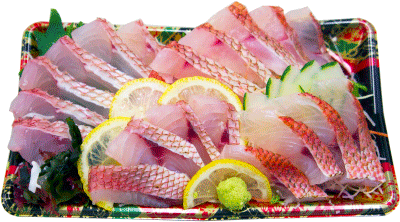
Yakijimo sashimi of ruby snapper is divided into half-length in dorsal and abdomen, skin in the top, and finish it by cutting thin.
Well ruby snapper is not only delicious as sashimi, as the material of fish suitable for such other to boiled or pan cooking.
The image below, the ruby snapper not uncommon to become more size 5�s is relatively small before and after size 700g, which was the product with each further half this side of the body. Intro image thus has dished the "1/4" of minute halves that were commercialized.
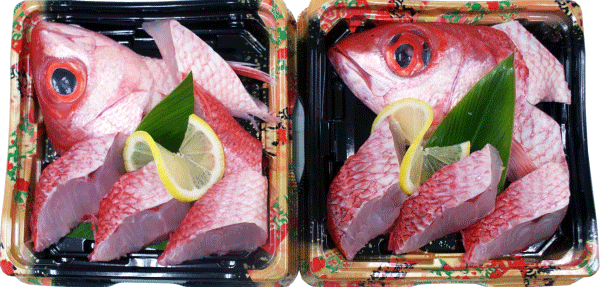
Since ruby snapper is a luxury fish of white meat, purchase price also taking into account the fact that relatively high, above images have been in the product in one only 4 minutes, as shown in the following image as long as it can get if at a cheap price also it would be good as a half-length of the goods.

Each of the slices products that Serve these one fish of quarter and half-body, which is also using the side of the body with a bone, yet the head that was in half with a portion of the sickle that have put together there is a the common term, which is based on deliberate idea.
Half-length of boneless is utilized as sashimi for material of the shown above none skin sashimi had and yakijimo sashimi, the assumption that half the 1 fish in for sashimi, and use half for slices, and to expand into both products I'm with.
This is a technique to sold under another value in halves a fish, because SKU is spread, so that the increased attractive fish sales by doing this.
Also if putting Any goods fillets head, but also contemplated is one to want to show increasingly voluminous by adding this, not only that.
Generally, fish head, have been treated as a poor site worthless part of such as red snapper and yellowtail as an exception, under the name ara, being sold for next to nothing of price.
The head is money even for next to nothing is still allowed, is a reality also there are many that have been discarded as it is to the residuum container as waste in, instead of so much hard-hearted handling these are decent some purpose to want admit the value.
The fish that, if cooking miso soup and boiled, etc. pot cooking, not only from fish body, made delicious soup stock out by umami components exiting from the bone marrow. But these days is on the grounds that "a child is reluctant to bone of fish", and I wonder and is age is avoided "fish with bone", and this miserable tendency, such as if pandering to "no fish bone fillets" seems factory products have in circulation for.
Originally in the fat in the eye behind the fish's head, to have been included many DHA and EPA, often such as collagen to many fish gelatinous on the head. So cuisine such as by the leftovers of fish such as miso soup eat up, leaving only bone would say that's the best way to eat in the sense that "take advantage fullness to the fish."
The author remains in most memory in the "fish of miso soup" that ate so far, it is eaten in Himi fishing port of Ishikawa Prefecture, on the morning of October 29, 2008 "kabusu miso soup."

Kaiho dining room that is in the Himi fishing port is a shop that is open the fish market employees as a major customer, kabusu miso soup on the image has become a Himi fishing port of specialties.
Kabusu miso soup, looking at the signboard, that are hung on the wall of the dining room, seems there is a origin marked in the image below.
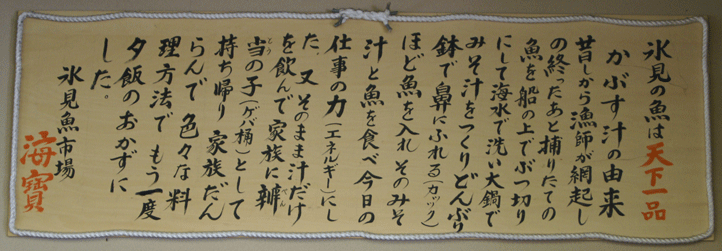
And because of something you have any such origin, it may be the kabusu miso soup would be to buy the anger and would say that's the same as the "fish of Ara miso soup." At that time "in the Kabusu miso soup, horse mackerel, mackerel, barracuda, small sea bream, squid tentacles, such as blue crab, was a splendid taste contains are a wide variety of fish chopped" and, after a meal of impressions the author wrote .
Kabusu miso soup of contents, but is of course not the Ara, the that the significance of existence is not in any way change the "fish of Ara miso soup." This might be a rude words, but actually eat feel is really was "similar ones."
Things Himi fishing port and Kabusu miso soup, because it mentioned among FISH FOOD TIMES ��59 Fukuragi figure sashimi (November 2008), I hope if you are interested take a look also here.
Now a simple table, it is not intended that uses a fine fish material as in kabusu miso soup, using the ara of the fish that remain after securing the sashimi or fillets, and therefore tried to summarize the points to make the fish Ala miso soup, which I want you to to one reference person did not have much edge to these up.
| How to make a point of Ara miso soup of fishs | |
|---|---|
| �P | I cut the head to an appropriate size. Part of the jaw and gills I do not use |
| �Q | Since the fin is issuing the smell, I cut off this |
| �R | Organs such as liver and heart, if there are more like medium bones, washed with water, and wash the blood and dirt and to use these |
| �S | To remove the stains of the fillets by the Yushimo, also removed smell |
| �T | In release flowing water remaining to remove scales and blood, and remove the dirt again |
| �U | When taken coarse heat to remove the moisture by up sieve |
| �V | Put the Ara in cold water and heated water in the state, weakening the fire after boiling |
| �W | In order to bring out the umami without an odor, remove carefully the scum of floating fish come |
| �X | Without the high heat, remain low heat, bring out the umami and fat slowly and carefully |
| 10 | Finally I put the miso. It is not boiled and after putting the miso |
 |
|
To eat delicious fish, rather than flee to the "way of eating Keep away the bone of fish", as the fish of fault with miso soup, "umami component emanating from the bone also take advantage" it is important towards the people of cooking.
However, in Japan now, and by the fact that "umami" of the fish has not been firmly understanding, fish dishes referred to as "First Fish", and are swayed by easy and convenient ready-made products that are produced in the factory to the direction, Japanese consumers there are things that I think or not than being directed.
To begin with what is a "umami"? And examine the reference materials and ...
In 1908 which is also more than 100 years ago, Kikunae Ikeda of Tokyo Imperial University professor found that the identity of the taste of kelp soup stock is glutamic acid. And was designated as "umami" the taste that can not be explained by the four basic tastes of sweet, salty, sour, bitter as the "fifth basic taste". The patented in seasoning of the manufacturing method as a main component that glutamic acid, was released from the May 1909 is the seasoning of umami "Ajinomoto" Suzuki pharmaceutical plant (now of Ajinomoto Co., Inc.).
Because there is no word to describe this "umami" in English today, are internationally now "umami" is used as an academic term. This was found to be "there are organizations that feel the umami component to the tongue" made in the 1980s, finally came to be recognized worldwide as a "fifth taste". While the long also about 80 years since the discovery umami, researchers in Europe and the United States is a sense of appearing as the harmony of the four basic taste of that "umami", it was had been that it is not a basic taste.
In Japanese cuisine, it but take the soup stock in katuobushi after taking the soup stock in the kelp, it Together with amino acid-based glutamic acid and katuobushi of nucleic acid-based inosine acid of kelp, obtained a much stronger umami than when each is alone it is you're coming from the cook of experience value of becoming so.
That, along with rich fish inosinic acid, and kelp rich glutamate, and cooking the combined plant foods such as mushroom guanylate, so that the umami is stronger very. And the umami of the mild taste compared to other basic tastes, moreover, is characterized by catching a long aftertaste.
Miso soup that Japanese have been eating every morning from the old days, and animals of rich dried sardine inosine acid, together miso that glutamic acid of vegetable contains plenty, is of that delicious taste is out.
In every morning of miso soup, if the hidden taste dried sardine does not come out to the surface, fish of Ara miso soup is different from that fish of Ara has become a "leading role that came out on the surface" contrary to the dried sardine . That is animal of inosine acid-rich crude is he only has reverse of glutamic acid and master-slave vegetable miso.
Quickest way to understand the taste of miso soup sensuously is to travel umami of soup is more than a week to the base in the West of the country there is no food, and not eat Japanese food, such as any miso soup meantime, it is to drink the usual miso soup in the morning of the home that you return home.
And drank the miso soup while to taste on the tongue, perhaps "miso soup is something very delicious ..., good!" It should be inspiring.
In order to say the fish cuisine "delicious!", It is necessary that I'll well pull out the umami components with fish. To do so, do not just think the only thing you want to pandering to the needs of consumers who do not want to do also troublesome is not well known that fish. I think really that what to do if I want to eat delicious fish, and thing seller side it is also important to teach the consumer.
"Policy for the consumer to the stupid" that first fish is only lazy housewives responsible for the day-to-day cooking. Such approach is believed to lead to not knowing the real taste of fish. Such a "fish-eating dissemination of a stopgap measure" in consumption up wherever the fish as a result I think or not than not lead.
May further, for the seller side to sell the fish, rather than use his head on things like sell at a cheap price, such as 100 yen fish fillets, How can to inform the customer that there is also a utility value to the fish head also it is what you want to use your head things like whether.
Always that stable fish prosperity shop with sales, Whatever the economy, than things like create a temporary foaming sales in the cheapness of short-term, in order to grasp the customer brings the future stable sales seems somewhat selling price is higher also provide the steady high quality products often shop that has continued plugging away the "business of genuine intention".
"a genuine intention" is by no means the same meaning as the word luxury. Fish head also, and ara also know the art of leverage that is not to waste as basic, there is a know-how that can teach it to you, moreover, stores like are assortment actually it as a commodity in the department I wonder not to say things.
If is your shop customers are as many people that do not know the real taste of fish, it should not be recommended ready-made goods of simple and easy manufacturer for such customers. The important thing is, while a good season of fish freshness, and assortment of fish of high quality a genuine intention, is that it is going to tell a steadily plugging away the goodness of the product to the customer, such is lost the that no effort, would be to go led to significant sales to wherever.
FISH FOOD TIMES in order for people stacking such efforts, it is one that I think if you can help one end of its the role.

Date of updating |
Apr.1, 2015 |
Food commerce contribution sentence
| Food commerce contribution sentence (foregoing volume) |
An opinion and the communication are to info@fish food times